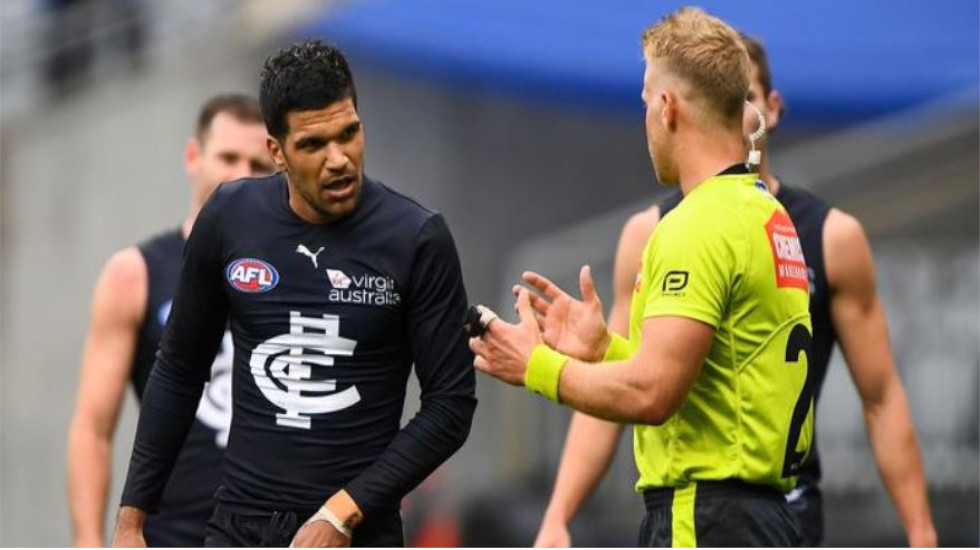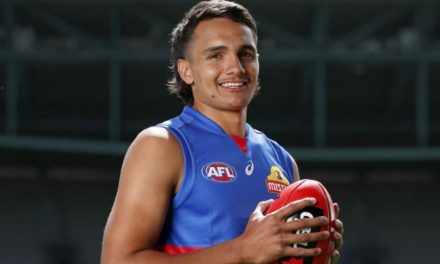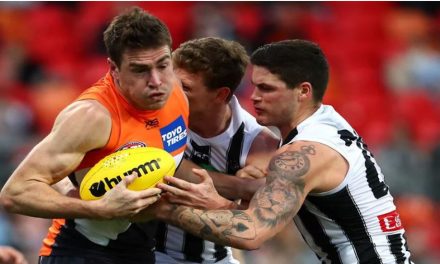Umpire Nathan Williamson explains a decision to Carlton’s Sam Petrevski-Seton in Perth last Sunday. Photo: GETTY IMAGES
Luke Beveridge’s comments should have set alarm bells ringing at AFL House. Instead, they seem to have fallen on deaf fears.
“We pretty much just gloss over it, we don’t talk about it,” Beveridge told reporters in a digital press conference this month.
“There’s too many other things that we need to focus on and too many things that we need to get right in the game to be concerned with that. It’s a significant part of the game because it can win and lose games, but we’ve just got to control what we can control, and that’s one thing we can’t.”
The vexing subject? The AFL’s new interpretation of the holding the ball rule, of course.
Beveridge continued: “It’s a shame. We can’t address it, because we don’t know what the interpretation is going to be and we’re not sure what the rule is.
“We’ll just play and our players will just do their best to make sure we clear the ball when we get tackled, and maybe take the opportunity to really clamp down when the opposition get the footy.”
If an AFL premiership coach can’t get his head around it, what hope do you or I have? There’s no obvious solution, but one simple step could go a long way towards clearing up the confusion.
The AFL needs to put footy operations boss Steve Hocking in front of a video camera as soon as possible.
Arm him with video clips – examples of what does and doesn’t constitute holding the ball these days – and make them available to anyone and everyone who wants the explanation. If it sounds like we’re all going back to school, then good. That’s what we need.
Following the Adelaide-St Kilda game on July 20, the AFL made a feeble attempt at clearing up the rule and new interpretations in a statement.
“Earlier this season, we identified a number of instances where players failed to make a genuine attempt to dispose of the football when legally tackled and should have been penalised for holding the ball (no genuine attempt),” Hocking said in the statement.
“This was then communicated to clubs with the following description: Where a player is in possession of the football and has not had prior opportunity, a field umpire shall award a free kick if the player is able to, but does not, make a genuine attempt to correctly dispose of the football when legally tackled.”
The league then re-issued “Rule 18.6 holding the ball” and each of the five sub-points. Clearly, it wasn’t enough. Confusion still reigns three weeks later.
Carlton coach David Teague was left miffed by a series of umpiring decisions during his side’s defeat to West Coast on Sunday.
“Our players are seeking a fair bit of clarity around it at the moment,” Teague said. “It’s a hard one. Any time you change an interpretation through the season, it’s quite hard – as much for the umpires – to adjudicate.
“Whether the umpires felt that was right or wrong that call, I don’t know because they’re going to make mistakes as well. So it’s hard for us as coaches and players to understand which one was an error and which one wasn’t to get a pattern going forward.”
There was a time the AFL used to gather media representatives in each major football centre to go through video footage and explain new rule interpretations and tweaks ahead of the coming season.
Umpiring department representatives were available to answer questions and engage in discussion around any changes put in place. Clubs have a similar arrangement for players and football department staff.
Let’s go back to school with Headmaster Hocking and get some real clarity around the rule causing more headaches than anything else we’re seeing on the field right now.
And while we’re clearing up holding the ball issues, can we get a few pointers on the deliberate out of bounds rule, too?












Prior opportunity is stupid.
It used to be that once tackled (forget what you did before)
1.you had a reasonable time to dispose of the ball legally either by hand or foot.
2.If you tried to dispose of it by foot and you missed and it hit the ground, it was a free against you.
3.If you were tackled in a bear hug so to speak then it was a ball up if you couldn’t dispose of it.
4.If the tackle (and not the possessor of the ball) dislodged the ball before you could dispose of it it was play one.
5. Just letting go of the ball was a free kick against you.
It isn’t hard.
Prior opportunity is just a ridiculous concept that was introduced in the 90s when people were upset that player who bounced the ball 5 times and then got tackled in a bear hug, got a ball up and not called for holding the ball.
They thought that wasn’t fair. So in came prior opportunity.